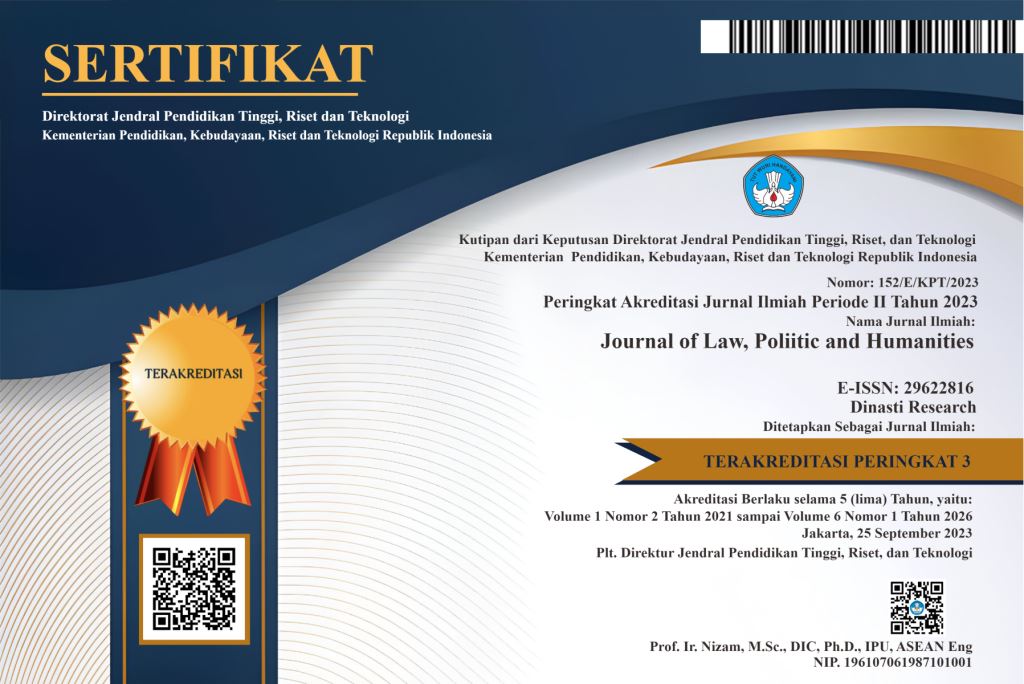Medical Dispute Resolution by Using Peace Principles
DOI:
https://doi.org/10.38035/jlph.v5i4.1717Keywords:
Medical Disputes, MediationAbstract
The national development program in the health sector seeks to improve the level of public health. In an effort to realize the goals of national health development, the medical profession is a noble profession that is the main pillar. The provision of health services involves doctors and patients who are legal subjects involved in the field of health care and create medical and legal relationships. This relationship can cause conflict in its implementation. Lack of good communication and unsatisfactory quality of information from doctors to patients are the main triggers of conflict. In general, disputes in the health sector are resolved through the judicial system, which tends to cause disputes. Alternative dispute resolution is an approach to resolving conflicts amicably, without involving the courts. The most important and effective form of this approach is mediation. The advantage of using mediation is that the procedure is simple, effective, speeds up the process of resolving cases, lowers costs, provides an opportunity to achieve resolution of problems by agreement, and The decision is still under the control of the parties to the dispute. Mediation contributes to the maintenance of healthy relationships between the involved individuals or groups by ensuring their dedication to the mediation outcome and providing legal options in case of non-fulfillment
References
Balzer, B., & Schneider, J. (2021). Managing a conflict: optimal alternative dispute resolution. The RAND Journal of Economics, 52(2), 415–445.
Bayer, S., Kuzmickas, P., Boissy, A., Rose, S. L., & Mercer, M. B. (2021). Categorizing and rating patient complaints: an innovative approach to improve patient experience. Journal of Patient Experience, 8, 2374373521998624.
Bhavnani, V., & Fisher, B. (2010). Patient factors in the implementation of decision aids in general practice: a qualitative study. Health Expectations, 13(1), 45–54.
Bishop, T. F., Federman, A. D., & Keyhani, S. (2010). Physicians’ views on defensive medicine: a national survey. Archives of Internal Medicine, 170(12), 1081–1083.
Frosch, D. L., May, S. G., Rendle, K. A. S., Tietbohl, C., & Elwyn, G. (2012). Authoritarian physicians and patients’ fear of being labeled ‘difficult’among key obstacles to shared decision making. Health Affairs, 31(5), 1030–1038.
Hyman, C. S., Liebman, C. B., Schechter, C. B., & Sage, W. M. (2010). Interest-based mediation of medical malpractice lawsuits: a route to improved patient safety? Journal of Health Politics, Policy and Law, 35(5), 797–828.
Hyman, C. S., & Schechter, C. B. (2006). Mediating medical malpractice lawsuits against hospitals: New York City’s pilot project. Health Affairs, 25(5), 1394–1399.
Joseph-Williams, N., Elwyn, G., & Edwards, A. (2014). Knowledge is not power for patients: a systematic review and thematic synthesis of patient-reported barriers and facilitators to shared decision making. Patient Education and Counseling, 94(3), 291–309.
Kachalia, A., & Mello, M. M. (2011). New directions in medical liability reform. In New England Journal of Medicine (Vol. 364, Issue 16, pp. 1564–1572). Mass Medical Soc.
Mello, M. M., Chandra, A., Gawande, A. A., & Studdert, D. M. (2010). National costs of the medical liability system. Health Affairs, 29(9), 1569–1577.
Mokhtar, M. F. M. (2022). Medical negligence dispute in Malaysia: choosing mediation as the best constructive approach to address the paradoxes in medical negligence claims. European Journal of Natural Sciences and Medicine, 5(2), 75–87.
Sohn, D. H., & Sonny Bal, B. (2012). Medical malpractice reform: the role of alternative dispute resolution. Clinical Orthopaedics and Related Research®, 470, 1370–1378.
Szmania, S. J., Johnson, A. M., & Mulligan, M. (2008). Alternative dispute resolution in medical malpractice: a survey of emerging trends and practices. Conflict Resolution Quarterly, 26(1), 71–96.
Weinstein, S. L. (2009). Medical liability reform crisis 2008. Clinical Orthopaedics and Related Research®, 467(2), 392–401.
Downloads
Published
How to Cite
Issue
Section
License
Copyright (c) 2025 Cep Juli, Efa Laila Fakhirah, Anita Afriana

This work is licensed under a Creative Commons Attribution 4.0 International License.
Authors who publish their manuscripts in this journal agree to the following conditions:
- The copyright on each article belongs to the author(s).
- The author acknowledges that the Journal of Law, Poliitic and Humanities (JLPH) has the right to be the first to publish with a Creative Commons Attribution 4.0 International license (Attribution 4.0 International (CC BY 4.0).
- Authors can submit articles separately, arrange for the non-exclusive distribution of manuscripts that have been published in this journal into other versions (e.g., sent to the author's institutional repository, publication into books, etc.), by acknowledging that the manuscript has been published for the first time in the Journal of Law, Poliitic and Humanities (JLPH).


























